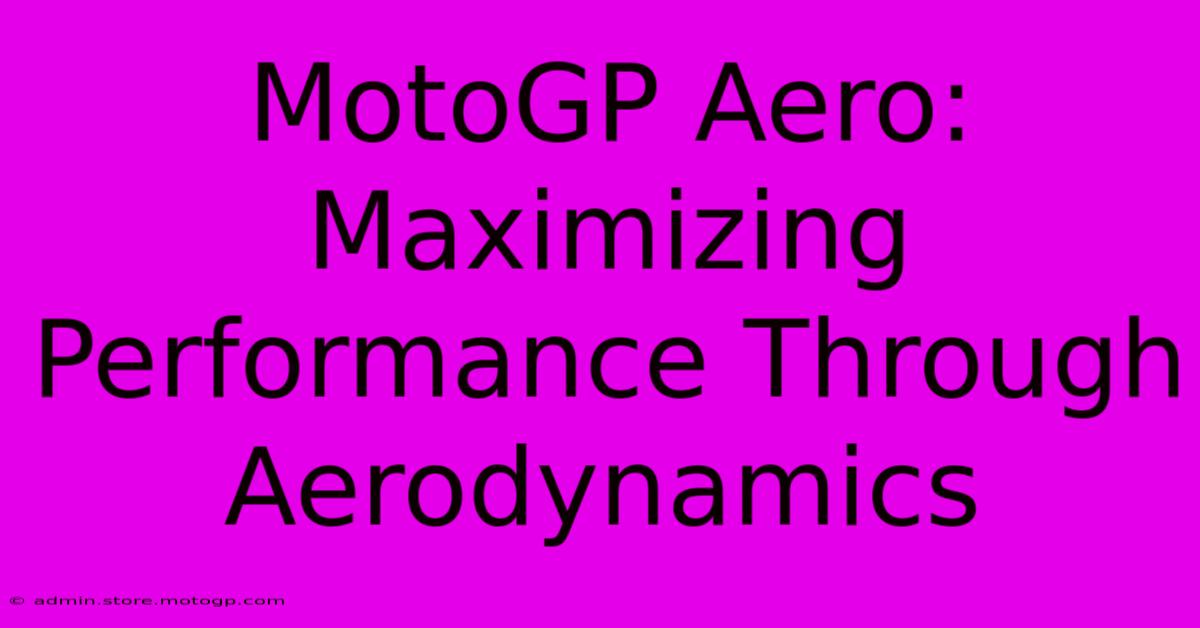MotoGP Aero: Maximizing Performance Through Aerodynamics

Table of Contents
MotoGP Aero: Maximizing Performance Through Aerodynamics
MotoGP racing is a relentless pursuit of speed and performance. Every tenth of a second counts, and teams constantly search for innovative ways to gain an edge. One crucial area where advancements translate directly to lap times is aerodynamics. This article delves into the world of MotoGP aero, exploring how these intricate aerodynamic designs maximize performance and the constant evolution driving this technological arms race.
Understanding the Importance of Aerodynamics in MotoGP
Aerodynamics play a pivotal role in MotoGP. At speeds exceeding 200 mph (320 km/h), even minor aerodynamic inefficiencies can significantly impact performance. The goal is to harness the power of airflow to:
- Increase Downforce: Downforce presses the bike and rider firmly onto the track, enhancing grip, especially through corners. This allows for faster cornering speeds and improved stability.
- Reduce Drag: Drag is the resistance that slows the bike down. Minimizing drag allows for higher top speeds on straights and better acceleration out of corners.
- Improve Stability: Aerodynamic devices contribute to a more stable platform, allowing riders to maintain control at high speeds and during aggressive maneuvers.
- Enhance Rider Comfort and Control: Well-designed aerodynamics can reduce buffeting and improve rider comfort, ultimately leading to better performance and reduced fatigue.
Key Aerodynamic Components in MotoGP Bikes
Modern MotoGP machines are festooned with aerodynamic devices meticulously designed to optimize airflow. These include:
- Fairings: The primary bodywork, shaping the airflow around the bike and rider. Design innovations constantly refine the fairing's shape for reduced drag and increased downforce.
- Wings: Strategically placed wings generate downforce, particularly at the front and rear. The size, shape, and angle of these wings are crucial in balancing downforce and drag. Their design is heavily influenced by Computational Fluid Dynamics (CFD) modeling.
- Winglets: Smaller wings that provide localized downforce, often positioned on the fairing or other areas to fine-tune airflow management.
- Airducts and Spoilers: These channels manage airflow to cool the engine and brakes while also minimizing disruption to overall airflow patterns.
- Underbody Aerodynamics: The underside of the bike plays a crucial role. Smooth surfaces and carefully designed channels underneath minimize drag and can generate additional downforce.
The Constant Evolution of MotoGP Aero
The world of MotoGP aerodynamics is in a constant state of flux. Teams are constantly innovating and pushing the boundaries of what's possible:
- CFD and Wind Tunnel Testing: Extensive simulations and wind tunnel testing are crucial in developing and refining aerodynamic designs. These tools allow engineers to visualize and analyze airflow patterns, optimizing performance before components even see the track.
- Material Science: The use of lightweight, high-strength materials such as carbon fiber is essential for building complex aerodynamic components that are both effective and durable.
- Data Analysis: Real-time telemetry data from the bikes provides valuable insights into aerodynamic performance. This data is used to fine-tune designs and optimize strategies.
The Future of MotoGP Aero
The future promises further advancements in MotoGP aerodynamics. We can expect to see:
- More sophisticated designs: Expect even more intricate and complex aerodynamic solutions as teams strive for marginal gains.
- Active aerodynamics: Systems that adjust aerodynamic components in real-time based on track conditions and rider input.
- Sustainable materials: Increased focus on environmentally friendly materials and manufacturing processes.
Conclusion:
MotoGP aerodynamics is a fascinating blend of science, engineering, and artistry. The relentless pursuit of aerodynamic efficiency is a crucial element in the quest for victory. As technology continues to advance, expect to see even more breathtaking innovations in the design and application of aerodynamics on the MotoGP grid. The battle for aerodynamic supremacy is an integral part of the exciting and fiercely competitive world of MotoGP racing.

Thank you for visiting our website wich cover about MotoGP Aero: Maximizing Performance Through Aerodynamics. We hope the information provided has been useful to you. Feel free to contact us if you have any questions or need further assistance. See you next time and dont miss to bookmark.
Featured Posts
-
The Heart Of Texas Austin Sprint Race Time Tradition
Feb 18, 2025
-
Sprint Race Results Overcoming Challenges
Feb 18, 2025
-
Sting F1 Breaking Barriers In Motorsport
Feb 18, 2025
-
Master The Turns A Comprehensive Overview Of Motorcycle Racing Types
Feb 18, 2025
-
Motorsport Mayhem Is There Any Racing On Tv Today
Feb 18, 2025
